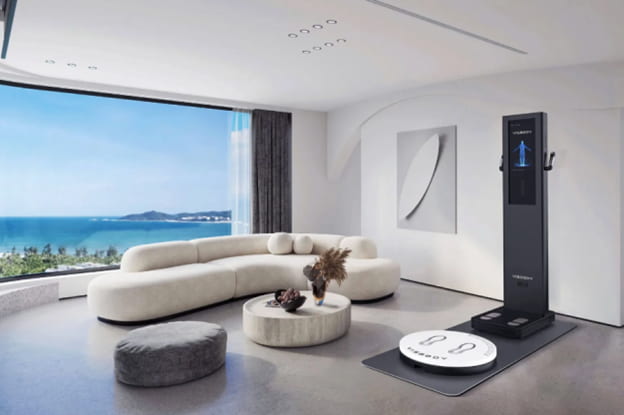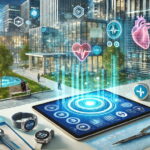Technology is transforming our approach to comprehending our bodies. One notable breakthrough is the 3D body scanner. This technology is changing the game by reinventing how people achieve their fitness objectives.
In this post, we’ll look at the practical uses of 3D body scanning, the benefits it provides, and its role in encouraging healthier living. Let’s explore its interesting realm and influence on our health.
Benefits of 3D Scanner Technology
Some of the best benefits of this technology are:
Accountability and Motivation:
Visualizing your body in three dimensions helps boost motivation and accountability. Individuals are more likely to stick to their exercise goals when they can clearly track their progress and see good improvements in their bodies.
Objective Self-Reflection:
3D body scans give an objective perspective of the body, which reduces subjective biases that may exist when using mirrors or subjective impressions. This encourages a more realistic and constructive self-image, resulting in a better attitude.
Immediate Health Warning:
Aside from aesthetics, 3D body scans can indicate health dangers, including posture difficulties or imbalances. Identifying these concerns early helps people to take proactive steps to avoid long-term health consequences.
Enhanced Fitness Tracking and Analysis:
3D body scanning goes beyond traditional fitness tracking methods by offering a more comprehensive analysis of body composition changes over time. By generating detailed reports on muscle growth, fat reduction, and overall body symmetry, individuals can make informed adjustments to their fitness routines.
This enhanced tracking not only aids in optimizing workout plans but also provides valuable data for understanding how different exercises impact the body.
Inclusivity in Fitness:
This body scanning fosters diversity in the fitness sector by accepting a variety of body forms. Traditional measuring methods may need to reflect the subtle differences across body forms.
However, 3D scans take a more inclusive approach, recognizing and appreciating the uniqueness of each person’s body. This inclusion promotes a healthy and tolerant fitness culture by defying traditional norms and encourages individuals to accept their bodies as they are.
Educational Tools for Health and Wellness:
This scanning is used as an instructional tool, providing individuals with a better understanding of their bodies. Training practitioners may use the visual depiction produced by these scans to educate customers on muscle imbalances, posture correction, and the value of a well-balanced training routine.
This educational element contributes to overall well-being by encouraging preventive actions to address future health risks, resulting in a more knowledgeable and health-conscious population.
Research and Development in Fitness Science:
Scientists who study how our bodies work and how to stay healthy really like the information collected from 3D body scanning. They can look at this data to discover trends and connections. It helps them learn new things about how exercise and what we eat affect our bodies.
Moreover, it adds to the improvement of fitness research, perhaps leading to advances in understanding how diverse elements impact individual reactions to training, allowing for more precise personalized fitness recommendations for the best outcomes.
Gamification of Fitness:
This scanning technology provides new opportunities for gamifying the workout experience. Fitness applications and platforms may use visual representations of the body to provide interactive challenges and competitions.
Users may participate in friendly tournaments based on their 3D body scan data, which promotes a feeling of community, motivation, and healthy competitiveness. This gamified method makes the exercise journey more pleasurable and sociable, increasing the likelihood that people will stick to their goals.
Redefining Body Therapy and Rehabilitation:
3D body scanning technology is getting much better in helping people with physical therapy and recovery. Therapists can use detailed 3D scans to check how your body is positioned, see improvements, and make plans for your specific recovery.
This accuracy helps a lot in making your recovery better, as therapists can focus on what you need. Using 3D body scanners in therapy is changing how doctors and therapists help people get better. It means they use more data and focus on what each person needs, making the healing process better and more centered around the patient.
Conclusion
Inspiring fitness journeys need a thorough understanding of the body, and 3D body scanner technology is playing an important part in attaining this. These scanners are changing the way people approach and interact with their fitness objectives by delivering precise measurements, personalized insights, and visual representations. As technology advances, the future offers great opportunities for a more connected, personalized, and powerful exercise experience.
Did you find this helpful? Check out our other helpful articles on our website.
Read Also
- Optimizing CT Protocols: The Hidden Key to Efficiency and Cost Savings in RadiologyIntroduction: Why CT Protocol Optimization Matters Computed Tomography (CT) is a cornerstone of modern diagnostic imaging, providing critical information across nearly every medical specialty. However, maximizing the value of CT — both clinically and financially — requires more than just advanced hardware. The real secret lies in the optimization of CT protocols. When CT protocols… Read more: Optimizing CT Protocols: The Hidden Key to Efficiency and Cost Savings in Radiology
- The Role of Carbide Burs in Modern Dental ProceduresAs a result of this procedures need to be well coordinated and to this end, precision tools are used by dental practitioners. Among the most essential tools in a dentist’s arsenal are carbide burs, which have revolutionized various aspects of dental work. Today’s dentistry cannot work without these tools as they are both strong, sharp,… Read more: The Role of Carbide Burs in Modern Dental Procedures
- Detection of Diabetic Retinopathy: The AI AdvantageDiabetic retinopathy (DR) is a leading cause of blindness among working-age adults, affecting millions worldwide. The prevalence of DR is alarmingly high, affecting an estimated 34.6 million people globally. In the United States alone, it is estimated that 7.7 million adults have some form of diabetic retinopathy. How Does Diabetes Affect the Eye? Most of… Read more: Detection of Diabetic Retinopathy: The AI Advantage
- Advances in Digital Health: Transforming Modern HealthcareThe healthcare landscape is undergoing a seismic shift with the advent of digital health technologies. These innovations are not just modern conveniences; they are transformative tools that bridge gaps in accessibility, improve patient outcomes, and empower individuals to take charge of their health. From wearable devices to telehealth and artificial intelligence, digital health is creating… Read more: Advances in Digital Health: Transforming Modern Healthcare
- The Latest Advancements in Urology ProceduresUrology, the branch of medicine concerning the urinary system and male reproductive organs, has seen remarkable advancements in recent years. Technological innovations have led to more precise, less invasive, and increasingly successful procedures that promise better outcomes for patients. From state-of-the-art robotics to personalized medicine approaches, the field of urology is evolving at a rapid… Read more: The Latest Advancements in Urology Procedures
- Navigating the Future of Healthcare: The Role of Technology and Innovation at Saint Luke’s HospitalIn an era of rapid technological advancement, the landscape of healthcare is undergoing a profound transformation. At the forefront of this evolution is Saint Luke’s Hospital, a leading medical institution in Los Cabos, Mexico. With a commitment to providing cutting-edge care to its patients, the hospital is harnessing the power of technology and innovation to… Read more: Navigating the Future of Healthcare: The Role of Technology and Innovation at Saint Luke’s Hospital
- 8 Tips For Aligning Optical Systems In Medical DevicesProper alignment is crucial when working with optical systems in medical devices. Even the slightest misalignment can throw off measurements and affect diagnostic accuracy. This article provides straightforward tips to help ensure precise optical alignment for reliable medical results. Start With The Basics Before getting into the nitty-gritty of alignment, it’s important to understand some… Read more: 8 Tips For Aligning Optical Systems In Medical Devices
- The Evolution of Orthodontic Technology: Exploring the Innovations Behind Modern BracesOrthodontic treatment has undergone a remarkable evolution over the years, driven by advancements in technology and materials. Modern braces represent the culmination of decades of research and innovation, offering patients more comfortable, efficient, and aesthetically pleasing orthodontic solutions. In this guide, we’ll delve into the technology behind modern braces, exploring the innovative techniques and materials… Read more: The Evolution of Orthodontic Technology: Exploring the Innovations Behind Modern Braces









